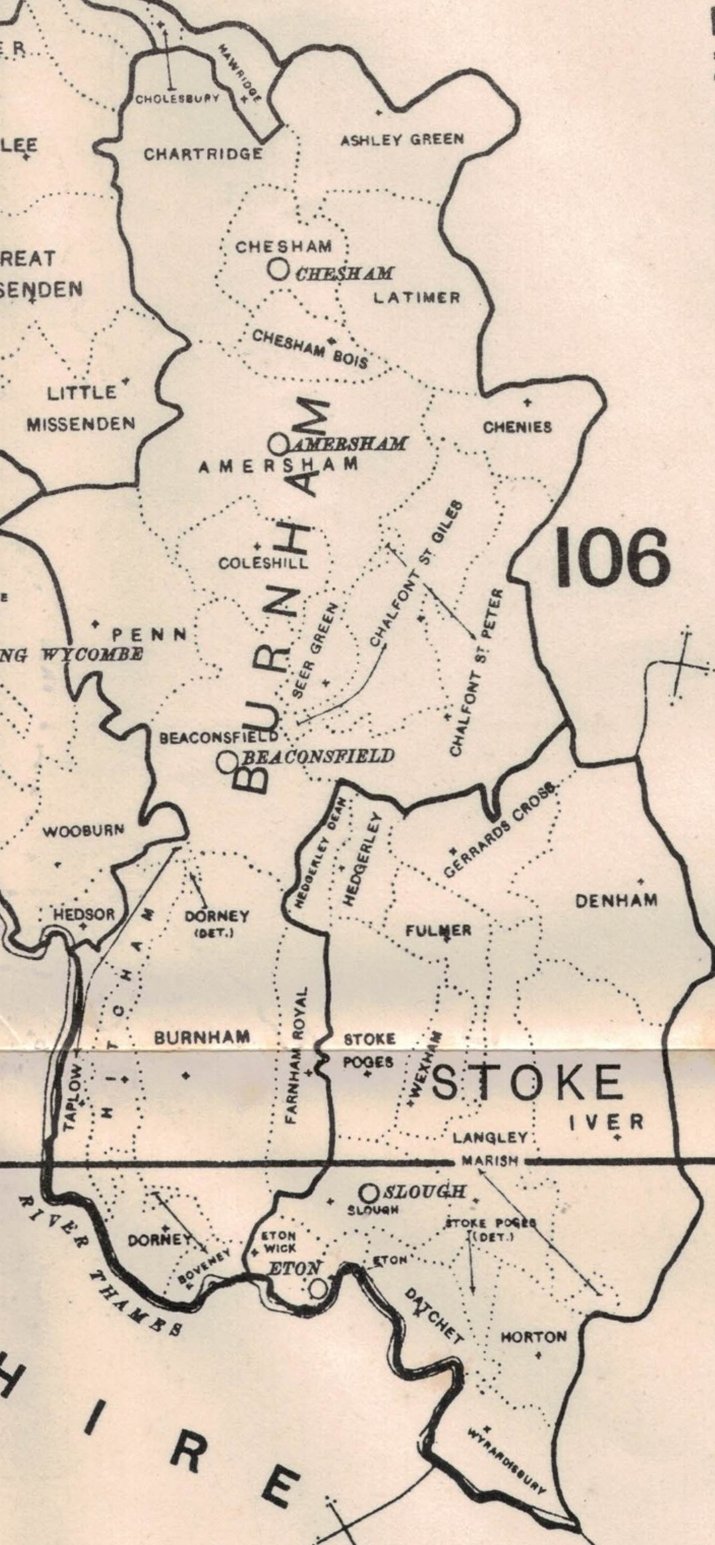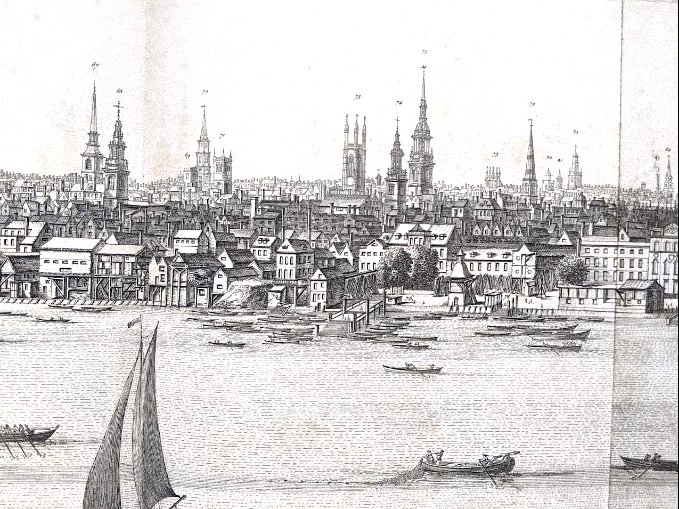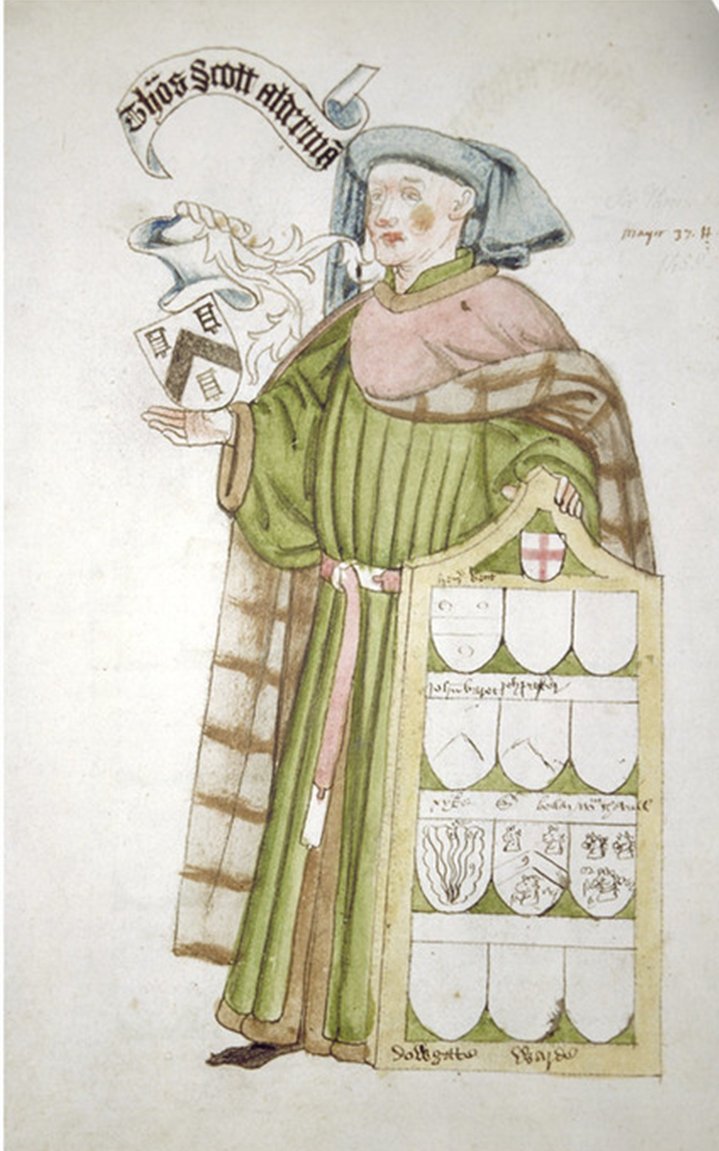The Name
Although the house now known as Baylins Farm was built in the 15th century, a homestead undoubtedly existed on the site more than a century before that. The name, which must be even older, has evolved (with variations) from Belynges to Byllynges to Bellings to Bealings only settling to Baylins in the 19th century. How the name originated is not clear. Consulting the Oxford Dictionary of English Place Names provides a few straws such as Baylham, near Ipswich, of which the first element is thought to be from the Old English word for a bend. Or there is Bealings (village in Suffolk) of which the first element is thought, like Belaugh, to stem from Old Norse for an interval and ‘might naturally have been used of a glade in a forest’. The second part of the name ‘Lynge’ seems to come from Old English ‘hlenc’ for a hill or rising ground. So, one could conjecture that Belynges indicated the bend in the road at Knotty Green where the house was tucked in a glade in the beech woods as the road from Beaconsfield to Penn begins to climb quite steeply. However, according to renowned place name expert, Margaret Gelling, ‘the name may simply refer to the bell-shaped edge of the common land which used to lie outside the farm and which is still to be seen outlined by the two tracks off Penn Road which meet at the foot of the ‘handle’ leading up to Baylins’.[1]
Earliest References
The earliest known references to Baylins occur in 1325 when Richard Dreu of Penn granted all the lands and tenements he had of the feoffment (grant of ownership) of John de Belynge in Beaconsfield to Ralf de Wedon, knight. In the same year Johannes Belynges, presumably the same man, was a member of the jury that held an inquisition on the death of John Segrave. Segrave’s manor was most probably the manor to which Baylins belonged at that period and Johannes would have been a tenant. The Manor Court Rolls show that Segrave Manor covered the southern quarter of Penn taking in Knotty Green, Forty Green, Drews Green, Witheridge Lane and Clay Street.[2] When an assessment was carried out in 1332 for King Edward III by Richard Dreu and Robert ate Oke for the purposes of taxation, ‘John Belling had 1 farm horse at 5/- and 1 cow at 6/- and 11 ewes at 11/- and 6 geese at 3/- and 1 qr. Of mixed grain at 3/4d and 4 qrs. Of oats at 6/8d’. Total 35/- on which he owed 2/4d. It sounds like a small farm at this period but, as a comparison, John de la Penne, the highest tax payer, had just 4 horses, 2 cows and 15 ewes, etc.[3] In 1345 Bartholomew de Bourne appointed John de la Penne as his attorney to receive seisin from John Belynges of all his lands and tenements in la Penne.[4]
In the fourteenth century a major tile-making industry flourished at Penn supplying many thousands of floor and roof tiles for such prestigious buildings as Windsor Castle and Westminster Palace. The clay was dug, the tiles were formed, fired and decorated locally. Simon Billyng, perhaps the son of John Belynges, is recorded in 1351 as Famulus (assistant) to Elie the paver who laid 258,000 of the 4 ½ inch square floor tiles, made in Penn, at Windsor Castle.[5]
Figure 1 Map of Burnham Hundred showing elongated parish boundaries of Taplow, Hitcham, Burnham and Farnham Royal. Note detached parts of Taplow and Dorney further north.
The history of Penn at this period is inextricably linked with parishes by the river Thames and in particular Taplow some 8 miles due south. Taplow is renowned for its 7th century burial mound indicating it had been a Saxon centre of civilization. Penn, with a 5 hide manor and some 600 acres under plough, was subsequently part of King Alfred’s royal estate. But the Domesday Book which surveyed much of England in 1086, makes no mention of Penn or Beaconsfield as geld was then paid through the manor at Taplow even though Penn was nearly fully developed agriculturally with 1500 acres of arable.[6] These links between settlements by the Thames and places higher up in the Chiltern Hills are thought to reflect the tradition of transhumance where sheep would be driven from lowland to upland pastures and back again later in the year. This in turn came to be reflected in elongated parish boundaries as shown in the map of the Burnham Hundreds.[7] At the turn of the C13th William Penn was ‘bound to carry his lord’s hay from Taplow to Penn’.[8] Further links become evident when King Henry VI set up Eton College in 1440 and endowed it with sufficient land, rights and other benefits to finance the education of 70 poor boys. This endowment included properties in Penn. Similarly, the lands of Dorney Manor between Taplow and Eton, which lies about 70ft above sea-level, had a substantial detached outlier indicated on the map and it must have also retained grazing rights around Knotty Green about 400ft above sea level.
Sir Thomas Scott, DraperDorney Manor in particular is of interest because its owner in the fifteenth century was Thomas Scott, whom we believe was responsible for constructing the timber frame hall house that survives as Baylins Farm today. In 1086 Dorney had been assessed at three hides when it was among the lands of Miles Crispin who also held Hitchham. Ownership went through various hands over the next two centuries before Thomas Scott, a draper from London, acquired it in 1430. His father, Robert Scott was from Dorney which explains his connection to the area. He held the manor until his death in 1470 when he left it to his wife Edith. She in turn left it to their son John Scott when she died in 1475, and he held it until 1505.[9]
Figure 2. from Buck’s View of London 1749 showing Dowgate Stairs (72) and Steel Yard Stairs (76). The Steelyard was the main trading base in London of the Hanseatic League during 15th and 16th centuries. The aspect of the shoreline had probably changed little since Scott’s time.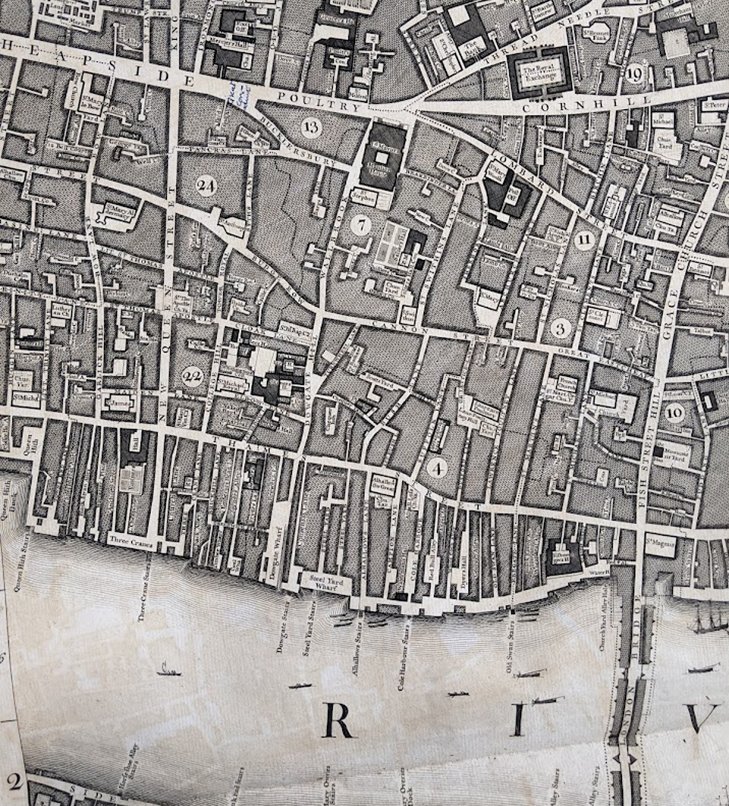 Figure 3. John Roque’s 1746 Map of London (engraved by John Pine) illustrates the position of Dowgate Wharf leading up to Wallbrook and Scott’s Yard off Bush Lane which led up to St. Swithins Lane.
Figure 3. John Roque’s 1746 Map of London (engraved by John Pine) illustrates the position of Dowgate Wharf leading up to Wallbrook and Scott’s Yard off Bush Lane which led up to St. Swithins Lane.
Thomas Scott was a successful draper in the City of London. He was a member of the Drapers’ Livery Company, one of the twelve Great City Livery Companies, which had been granted its first charter in 1364 by Edward III and enjoyed the monopoly of trade allied to the cloth industry. High quality English wool cloth was much in demand across Europe at the time and most of it was exported from London. Along the banks of the Thames near the only bridge in London across the river, the drapers had industrial buildings containing dyehouses and other activities concerned with the finishing of cloth. By the time Scott was coming to prominence as a liveryman, the Drapers’ Company had built their/its own hall in St Swithin’s Lane in the 1420s. He is recorded as subscribing to the cost of building the Hall in 1425 and served as Warden in 1434-5.[10] In 1438 the Company received a Charter of Incorporation making it a legal corporate fraternity. They also acquired their own coat of arms. However, Scott was not just an astute businessman as he went on to rise as a leader in the City as a whole.
On 29 April 1446, Thomas Scott was elected Alderman for Dowgate Ward a position he held until 1451. The southern boundary of Dowgate was the river bank where much of the draper’s activity took place and it was also one of the richest wards in the city. In 1447-8 Scott was also Sherriff. From 1451 to 1463 he transferred to become Alderman for Walbrook Ward, at the heart of the City and would have attended the weekly meetings of the Court of Aldermen responsible for running the City’s business. During that time he was Auditor from 1452 to 1454, but the pinnacle of his achievements came with his election as Lord Mayor in 1458 when he became Sir Thomas Scott. Five years later he was exonerated from duty as Alderman on 8 June 1463 on account of infirmity and died in November 1470 having made his will at the end of October. He was buried at the church in Dorney. A John Scott, gent, (presumably his son), was admitted to the Drapers Livery in 1486 by redemption.[11] The period between the end of the war with France in 1453 and the accession to the throne of King Henry VII in 1485, was a time when the wool trade flourished and wool merchants had money to spare.
Scott’s Yard off Bush Lane backed onto an important aristocratic city residence known as ‘The Erber’ which was arranged around a number of open courtyards and also had a beautiful enclosed garden hidden behind service accommodation. To the north of the yard was St Mary Bothaw’s church. After Scott’s time, the Draper’s Company acquired ‘The Erber’ including Scott’s Yard in 1543 and from the surviving (1596) plan it is evident that Scott’s Yard contained a row of warehouses from which he would have traded or sub-let to other traders. There was a wide yard suitable for receiving the delivery of goods. The whole area, including The Erber and the church, was destroyed by the Great Fire of 1666 and the buildings were not reconstructed, but the name Scott’s Yard survived on the road map until the 20th century even after Cannon Street Station had been constructed over it. One of the reasons given for Livery Companies acquiring such properties was in order to provide accommodation for members, who, despite their wealth, were not keen to invest in urban housing but ploughed back their profits into business ‘or into the acquisition of country estates.’[12]
Construction of the Baylins Farm c. 1450
Scott must have been successful in the drapery trade well before coming to prominence in the City because he had acquired Dorney Manor in 1430 and one of the prerequisites to becoming an Alderman was substantial wealth. He would have become more affluent as time went on. From analysis of timber samples by dendrochronology we know that Baylins Farm was built after 1448, around 1450, but until the discovery of Scott’s story there was no obvious explanation for why it was built then. Now we can begin to imagine that Scott wanted a house in the country that reflected his success and he therefore had a solid and impressive, timber-framed house built in the fashion of the time featuring a central high hall with two-storey wings at either end. At the lower end of the hall were the two service rooms while at the high end a solar would have provided a private space for the owners. This solar no longer exists and there is some speculation whether it really would have been built given the fact that the wing at the other end is so long. What remains is the three-frame, south facing, hall with a five-frame wing across the east end. The oak frames were infilled with wattle and daub. The first floor gable of the wing jettied out.
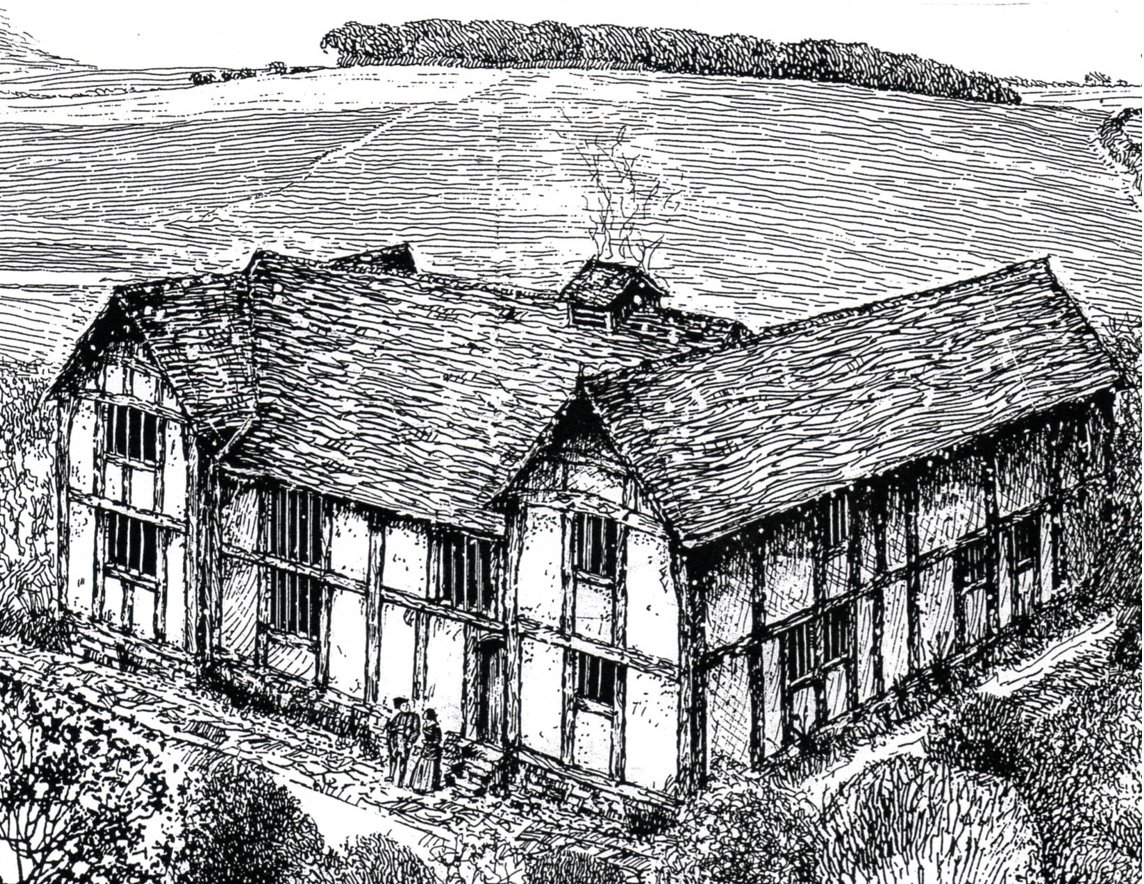 Figure 5. Baylins Farm as it probably looked when newly constructed c. 1450. (John Bailey)
Figure 5. Baylins Farm as it probably looked when newly constructed c. 1450. (John Bailey)
One of the puzzles identified by John Bailey, who researched the history of the building through a detailed examination of the timber frame from which the measured drawings used here as illustrations were produced, was the lack of window openings in the northern part of the first floor of the wing. He suggested that this probably indicated it was used for storage and not as living space. In view of Scott’s business, it is tempting to speculate that it was used to store wool or finished woven cloth. This would provide an explanation for the extra length of this wing.
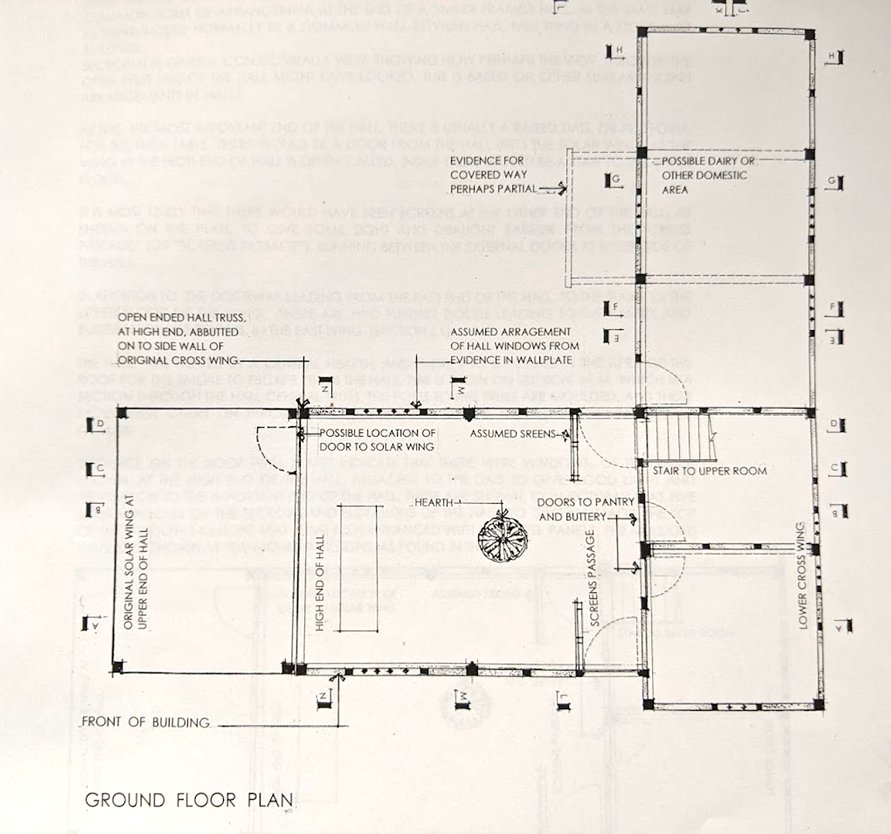 Figure 6. Ground floor plan of the timber frame of Baylins Farm showing the central hearth in the hall and the long east wing.
Figure 6. Ground floor plan of the timber frame of Baylins Farm showing the central hearth in the hall and the long east wing.
John Scott inherited his father’s lands following the death of his mother in 1475. We know from the Calendar of Inquisitions Henry VII, that among the properties he owned (at his death in 1505?) there was ‘a messuage in Penn called Bealynges and divers other lands in Penne’.[13] Could it be that Thomas Scott constructed a house at some distance from Dorney for his son John when John married Katherine? In April 1505 John sold most of his lands in Penn, as well as Saunderton Saint Mary, West Wycombe, Huchenden, Chepyngwycombe, to Sir Andrew Wyndesore. Excluded was a messuage in Penne called Whytes with a garden adjacent and certain lands held by copy of court roll of the manor of Segraves as well as Haldiffes in Penne and other lands there called Bailifes otherwise called Holmere [14] (Separately the reversionary interest in Dorney Manor was sold to Richard Restwold who in turn transferred it to Thomas Lytton). John Scott’s wife Katherine had already died and his son, also John, had died without issue, so John senior had to make these arrangements towards the end of his own life. His will, dated 20 August 1505, makes it clear he wanted to be buried at Dorney Church and he left money for a new steeple to be built. His daughter Isabell was a nun in the Abbey of Berkyng.[15] Andrew Windsor, the purchaser of the properties, undertook to found two chauntries and find two priests to pray for Scott’s family and Windsor’s family living and departed.
Lord Windsor & family
After John Scott sold Baylins to Andrew Windsor it became one of the Windsor family’s properties for four generations. Having said that, it seems unlikely that they made any personal use of the house during their ownership as they had plenty of grander houses available. The Windsors were descended from William Fitzother who had the Manor of Stanwell at the time of the Domesday Book. Andrew’s father Thomas Windsor was made Constable of the castle by Richard III. Andrew, aged 18, as the eldest surviving son inherited lands in Berks, Bucks, Hants, Middx, and Surrey upon his father’s death in 1485. He proved himself an able player in the power and wealth politics of the day, considerably augmenting the family’s wealth. During the reign of Henry VII he was appointed keeper of the wardrobe, a commissioner for subsidies in Middlesex and Berkshire and a JP. In 1509, a few years after he had purchased Baylins Farm, he was invested as Knight of the Bath at the coronation of Henry VIII. Closely involved with the King’s military expedition to France in 1513, he accompanied Henry’s sister Mary for her marriage to Louis XII the year after. In 1520 he attended Henry VIII at the Field of the Cloth of Gold and he was one of the commanders in the army sent to France in 1523. In 1529 he was admitted to the House of Lords as Baron Windsor of Bradenham and would share in some of the spoils from the dissolution of the monasteries. But in 1542 when Henry VIII came to stay at Stanwell the King obliged Andrew to surrender his traditional family home to the Crown. Andrew 1st Lord Windsor died the following year. In his Will he stated ‘that the issues of my manors of Bradnam, Weston Turvyle called Mullen’s manor, Weston Turvyle called butler’s manor and Belynges in Penne, with their appurtenances, in co. Buckingham, shall be taken by my executors for the performance of my will and payment of my debts which I owe the King’s highness for lands which I late bought of his Majesty, and other my debts, for the term of 17 years ensuing my decease.’
His son Sir William Windsor inherited the title becoming the 2nd Lord Windsor but he died in 1558, the year that Elizabeth I came to the throne. His will states that the income from ‘Bealinges’ and certain other manors be reserved for ‘Dorothee, Ladye Wyndesore late wife of Sr Thomas Wyndesore, knt for and during the space of 20 years.’ (Thomas was his youngest brother).
William was succeeded in turn by his son Edward born in 1532. Edward, 3rd Lord Windsor, is of interest as he was well travelled, well educated, and a cultured patron of the arts. His house in Bradenham, unusually for the period had rooms given over exclusively to the display of paintings and maps. Edward had been knighted by the Earl of Arundel following the accession of Mary to the throne (1553) and had fought at the battle of St. Quentin (1557) for which he was rewarded by the queen with a chain of gold set with rubies. The Windsors were steadfastly Catholic and loyal Tudors. Edward duly pledged himself to Elizabeth I but as time went on he found it increasingly difficult to reconcile the two loyalties. When Elizabeth went to visit Oxford University in 1566, Lord Windsor was in attendance on her and subsequently Elizabeth stayed at Bradenham from 7th to 9th September where she was entertained in great splendour. But in spring 1568 Edward departed for extensive travels in Europe, ostensibly for his health, which took him away for nearly two years. On his return ‘the reprisals towards Catholics in the parliaments of 1571 and 1572 appear to have convinced him that the remainder of his life should be spent abroad. In December 1572 he made his will, setting his affairs in order’ before setting out again to the continent. He spent the last year of his life in Venice and died there in February 1575 where his tomb can still be seen at the church of SS Giovanni e Paolo.[16]
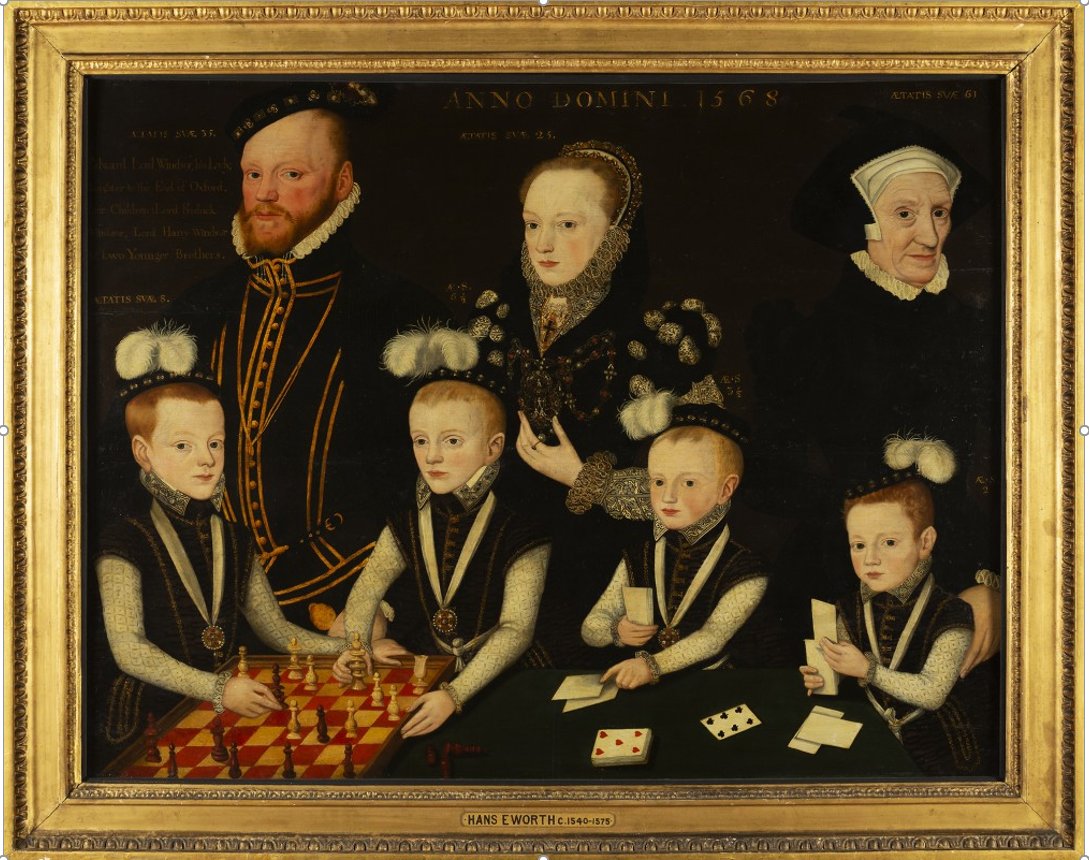 Figure 7. Portrait of the family of Edward Windsor, 3rd Baron Windsor, 1568. Bute Collection at Mount Stuart. Photo Keith Hunter. Edward Windsor (1532-1575), his wife Katherine de Vere (1543-1600), his four sons, Frederick, Henry, Edward jnr, Andrew, and an unidentified 61 year old woman. Painted by The Master of the Countess of Warwick (perhaps Arnold Derickson).
Figure 7. Portrait of the family of Edward Windsor, 3rd Baron Windsor, 1568. Bute Collection at Mount Stuart. Photo Keith Hunter. Edward Windsor (1532-1575), his wife Katherine de Vere (1543-1600), his four sons, Frederick, Henry, Edward jnr, Andrew, and an unidentified 61 year old woman. Painted by The Master of the Countess of Warwick (perhaps Arnold Derickson).
Edward Windsor’s lifetime coincided with huge swings in religious practice and tolerance. In 1540 when King Henry VIII was established as head of the Church of England, the Litany and the Bible were to be in English but Protestants who would not hear mass were burned as heretics, while Roman Catholics still loyal to the Pope were executed as traitors. Under the reign of King Edward VI new prayer books were introduced that were carefully worded so both Catholics and Protestants could use them and heretics were no longer burnt alive although zealous reformers pulled down altars, statues of saints and blotted out wall paintings. King Edward was succeeded by Queen Mary in 1553 who believed it her sacred duty to bring back the old faith. She persuaded Parliament to restore Latin Mass and she revived the law by which heretics would be burnt. When Queen Elizabeth came to the throne in 1558 it was decreed that the English Prayer Book should be used again and everyone should attend Church. For the first ten years of her reign most English Catholics were loyal to Elizabeth; they paid their fines for not attending church and held their own services privately. But in 1570 the Pope excommunicated Elizabeth so to Roman Catholics she was no longer lawful Queen. Ten years later new stricter laws against Roman Catholics were introduced with a penalty of £135 and one year in prison for holding a Catholic service. The fine for recusancy went up from 12d per week to £20 per month. To be an open Catholic meant ruin and imprisonment. Edward Windsor must have sensed the way things were going and got out in time although he was not to enjoy his life on the Continent for very long as he was 42 years old when he died.
Edward’s successor was his son Frederick as 4th Baron Windsor but the Fredrick died ten years later in 1585 and the title then passed to Frederick’s brother Henry (1562-1605) who thus became 5th Baron Windsor. It is known that the family’s finances were not good as, by the time Henry died, he had considerable debts. However Edward had bequeathed Billinges in his will dated 20 December 1572 to his youngest son Andrew and it was Andrew who actually sold Baylins Farm in 1593 to John Penn.
From documents in the Penn House Estate Archives we know that Andrew Windsor described himself as of Staplehurst, Kent and he did a deal in January 1593 whereby he ‘bargained and sold unto Jon Pen and his heirs all that messuage tenement and farm with appurtenances called or known by the name of Bealing in the parish of Pen co. Bucks and all other lands etc in Pen or elsewhere now in the tenure or occupation of one Richard Ognell for the sum of £900.’ In the four agreements relating to this sale the name of the property is variously: Bealing, Byllings, Billinges, Beelinges, Byllynges. Although the first document refers to Jon Pen he is after consistently John Penne.
Richard Ognell’s remaining lease was for 16 years from May 1593 for which he was to pay £34 yearly to John Penne. Ognell’s mother Anne, a widow, died in 1594 and was buried in the church at Penn. Amongst her legacies she left sums of money to her four daughters and one of her three sons, Laurence “if he demand it. The above legacies to be paid within one year after my decease, if same can be got out of the hands of my son George”. She also left a bullock plus 10 shillings to one grandson and two sheep and 20 shillings to his sister. Both were the children of Margaret Bingham. The residue of her estate went to Richard Ognell her son and he was to be her executor. The witnesses were John Pen and John Balam.
There remains one piece of the jigsaw puzzle concerning the Windsor’s ownership of Baylins Farm that is difficult to allocate. We know from dendrochronology that 1563 is the likely date for the installation of a first floor in the main hall of the house. The standard of the work with huge ovolo-moulded beams and joists was not simply functional but designed to impress but so far there is no information about who was living in the house at the time that would justify such works. Other alterations such as the installation of a circular staircase and the building of the two large chimney stacks would have been done at the same time. The octagonal newel post dates from c. 1557. Is it too far-fetched to imagine that somehow this was related to the passage of the Queen’s progress nearby in 1566? After leaving Bradenham, Elizabeth 1st dined with John Goodwin at Wooburn Manor, really close by.
[1] Miles Green, Penn Parish Council Annual Report 1995/96.
[2] Miles Green, Penn Parish Council Annual Report 1995/96.
[3] J. Gilbert Jenkins, A History of the Parish of Penn, St. Catherine Press, 1935.
[4] Eton College Collections on line, ECR 36 009.
[5] Miles Green, Medieval Penn Floor Tiles, 2003.
[6] Miles Green, Our Royal Connections, 2012.
[7] See also Simon Townley, Upland and Lowland in South Oxforshire Chilterns, https://blog.history.ac.uk
[8] J. Gilbert Jenkins, A History of the Parish of Penn, p. 8.
[9] Information from ‘Parishes: Dorney’, A History of the County of Buckingham: Vol. 3 (1925) pp. 221-225. Accessed via: www.british-history.ac.uk 27.04.2010. The present Dorney Court was built about 1510.
[10] Information from Penny Fussell, The Drapers’ Company archivist 11.02.2022.
[11] Boyd’s Roll, Past Master Percival Boyd’s register of the Drapers’ Company history.
[12] Sarah A. Milne, The Erber: Tracing Global Trade through a London Building, published online Cambridge University Press, 2020.
[13] Calendar of Inquisitions Henry VII Voll III, Bodleian Library. Information provided by Miles Green. It confirms that ‘the lands in Penne, worth 40s are held of Thomas earl of Derby, as of his manor of Segrave in Penne’.
[14] Eton College Collections Online, Ref. ECR 36 023. 1st April 1505. Sale by John Scotte of Dorney to Andrew Wyndesore … all appurtenances in … Pennes except messuage called Whytes with a garden adjacent in Penne.
[15] Will of John Scott of Dorney, 20.08.1505, proved 21.10.1505. National Archives. Records of Prerogative Court of Canterbury. PROB 11/14/726.[16] Information about the family portrait and Edward Lord Windsor’s life is taken from Edward Town’s study of the portrait and the man. www.artandthecountryhouse.com
Oliver Heal, January 2024

